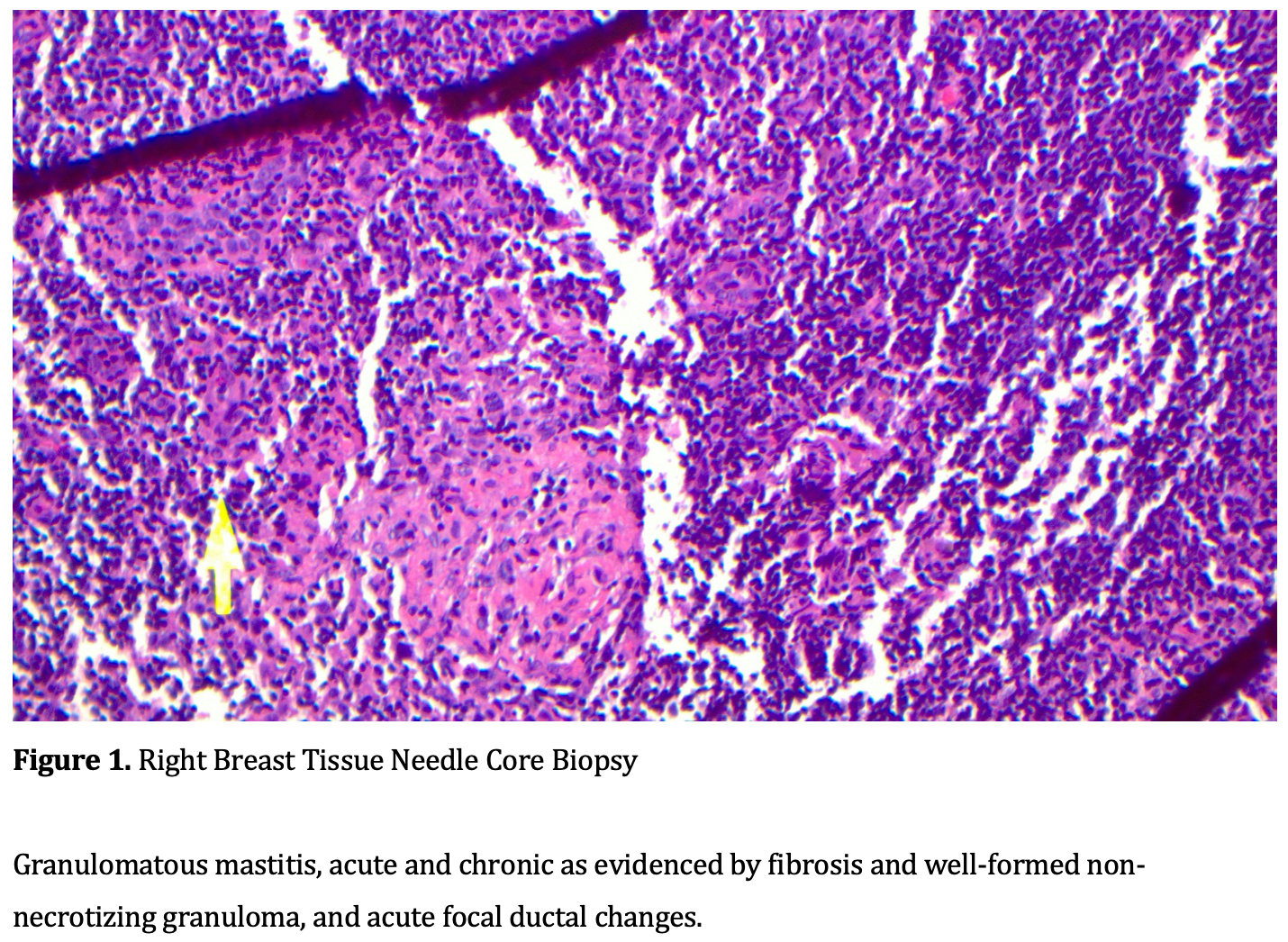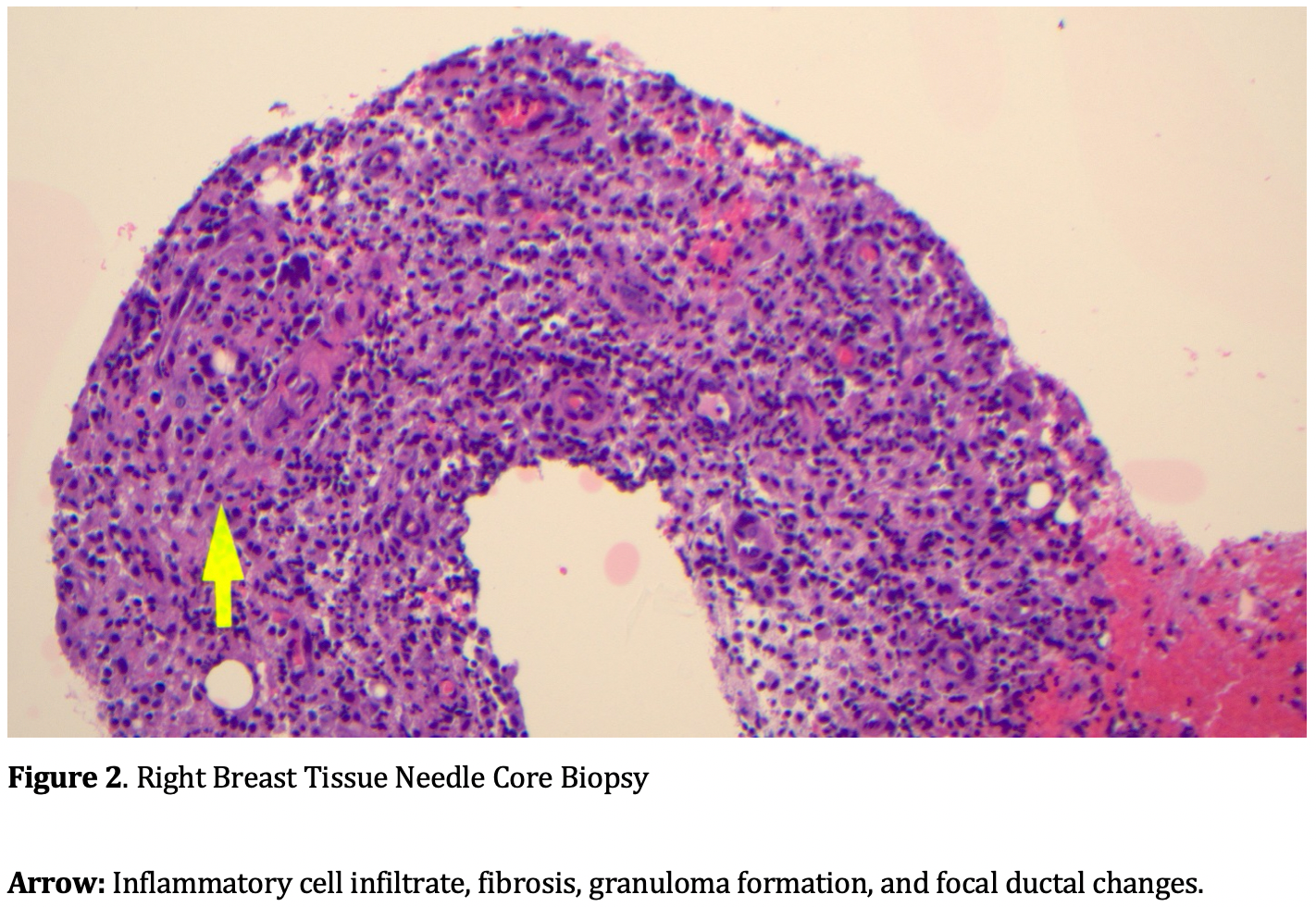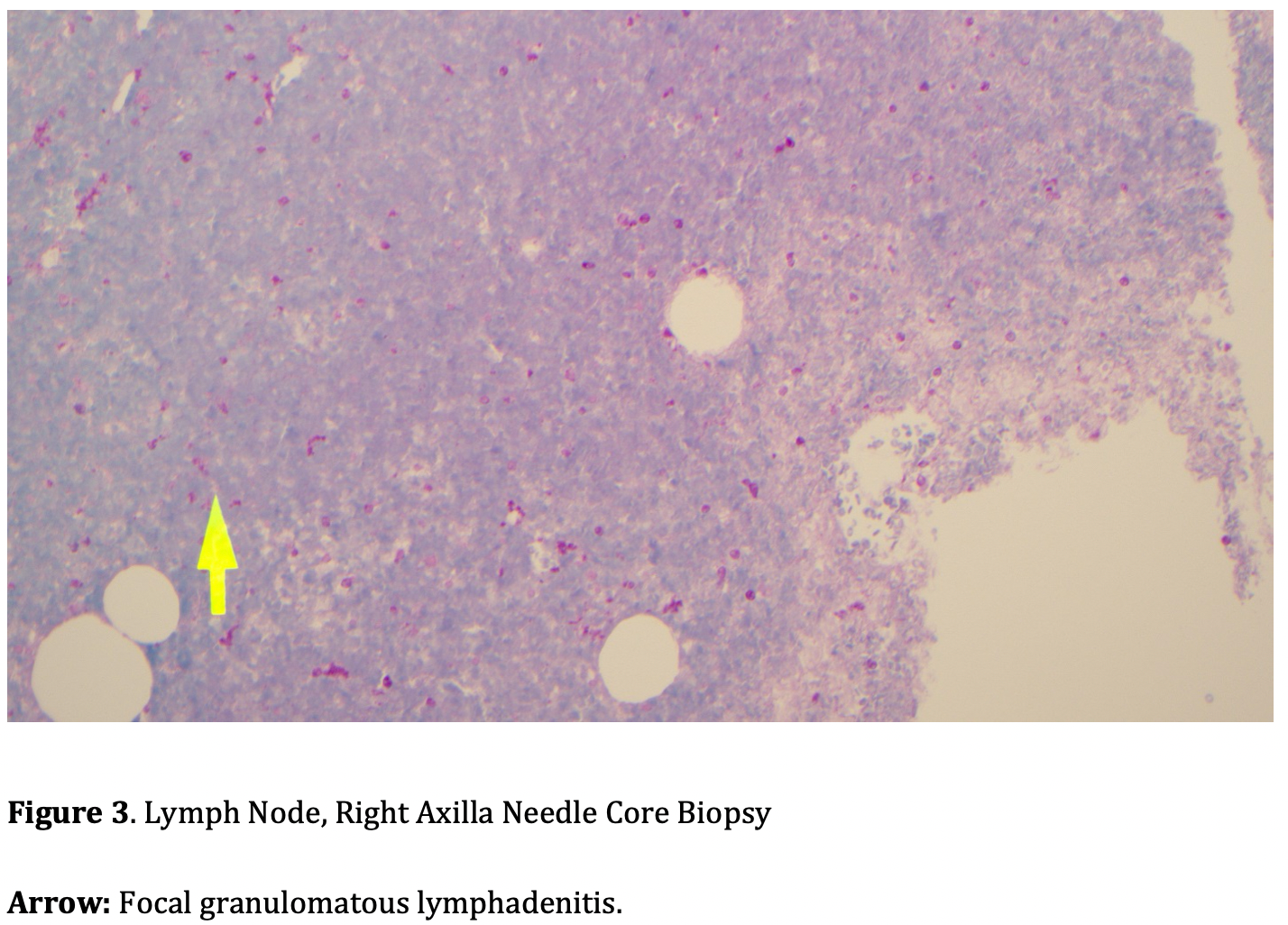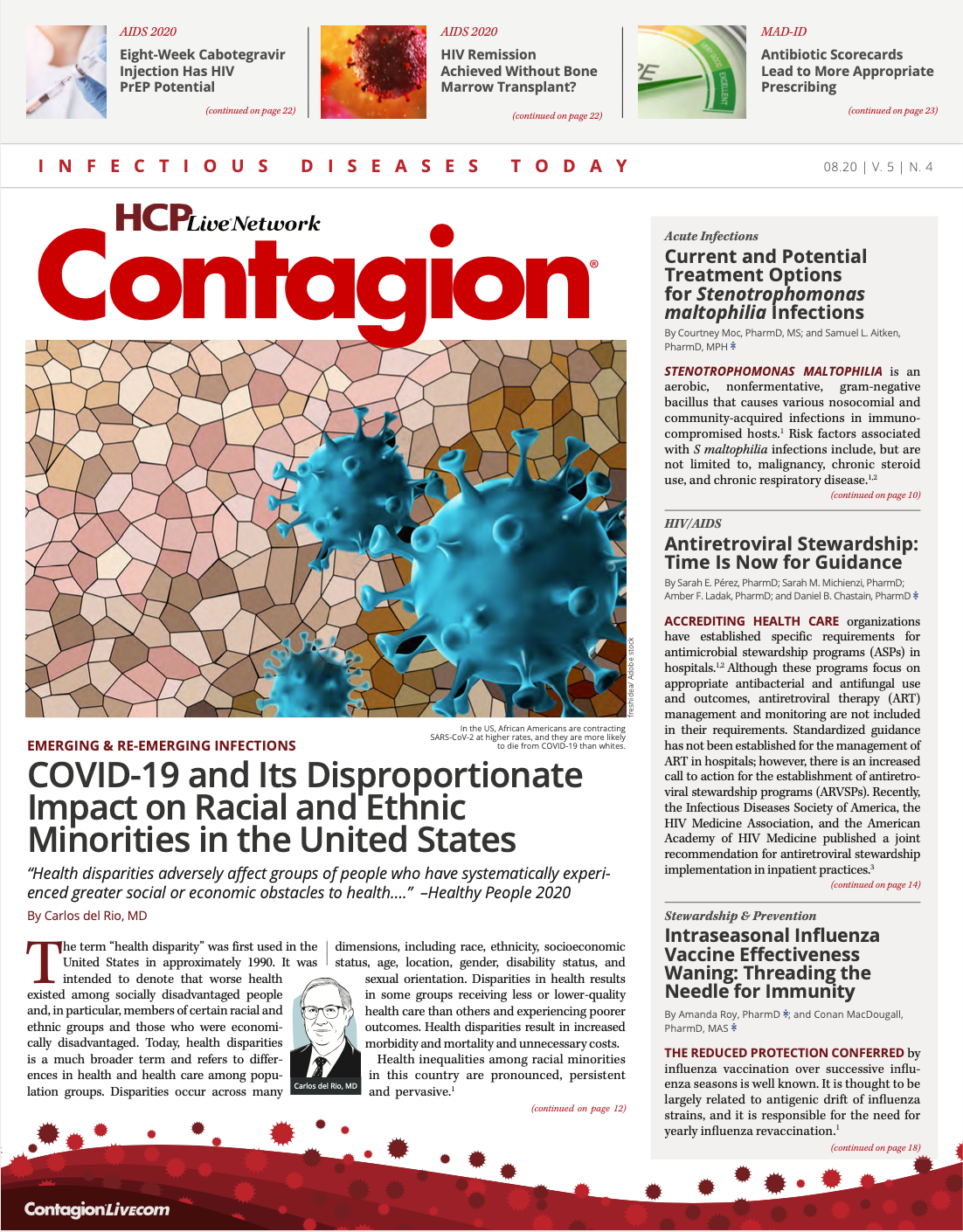A Case of Chronic Granulomatous Mastitis Caused by Corynebacterium kroppenstedtii
Clinically, C kroppenstedtii has been isolated largely from female subjects, with most samples resulting from breast tissue and the remainder identified in blood, sputum, lung, and prosthetic valve infections.
Final Diagnosis:
C kroppenstedtii mastitis
History of Present Illness:

A 32-year-old female presented to our emergency department (ED) due to 1 month of nonresolving right-sided mastitis. She was initially seen at another hospital due to 4 days of right-sided breast pain associated with greenish nipple discharge and intermittent fevers. She was diagnosed with uncomplicated mastitis and discharged on an oral course of clindamycin. However, she returned to that ED after 6 days with worsening breast pain and subjective fevers. During her second admission, ultrasonography (US) of the right breast revealed a complex fluid collection measuring 2.7 cm x 1.5 cm x 3.3 cm concerning for abscess development. She underwent incision and drainage. Cultures obtained at that time grew Corynebacterium minutissimum, which was felt to be nonpathogenic skin flora. She was discharged with a peripherally inserted central catheter and intravenous vancomycin and piperacillin/tazobactam, but she again returned to the ED after 14 days with little improvement in her symptoms despite completion of antibiotic therapy. Repeat US revealed multiple small, cystic structures concerning for further abscess development. She was offered repeat incision and drainage but declined, electing for discharge on oral clindamycin and outpatient evaluation at a breast clinic. She presented to our ED 6 days later due to persistent, intermittent fevers and worsening of right breast pain. She additionally endorsed chills, worsening breast edema, poor appetite, and nausea.
Past Medical History
The patient had had 1 pregnancy and 1 birth, an uncomplicated vaginal delivery 4 years prior. She additionally had a history of essential hypertension.
Key Medications
At presentation, she was taking only lisinopril—hydrochlorothiazide.
Epidemiological History
The patient was born in Haiti but had lived in the United States for more than a decade. She denied noticing any bug bites or trauma to the breast. She denied any recent travel. Her son and husband had no similar symptoms or other recent illness. She had no significant social, family, or sexual history.
Physical Examination
On presentation to our hospital, the patient was afebrile, saturating well on room air, and hemodynamically stable. She appeared uncomfortable but was in no acute distress. The right breast was visibly erythematous over the lateral aspect, exquisitely tender to light palpation, and hot to the touch. A firm, grapefruit-sized mass was palpable in the upper and lower outer quadrants. Her prior surgical incision was clean and dry with surgical packing. There was no purulent discharge. Her left breast was unremarkable.
Studies
Initial labs revealed a leukocytosis of 16,500 cells/μL with a normal differential. Her comprehensive metabolic panel was unremarkable. Erythrocyte sedimentation rate was found to be elevated at 61 mm/hour. Blood cultures were drawn. The remainder of labs were unremarkable.
Ultrasonography of right breast revealed diffuse, ill-defined soft tissue edema without evidence of a localized fluid collection or abscess.
Clinical Course:
The patient was initiated on empiric piperacillin/tazobactam and provided analgesia (acetaminophen/oxycodone). During her hospitalization, the patient continued to have severe pain in her breast and the margins of her erythema did not recede. She became tachycardic and remained intermittently febrile to 101 to 103°F. Her leukocytosis reached a maximum of 20,600 cells/μL and developed a granulocytic predominance. Initial incision cultures did not reveal growth of organism. Blood cultures remained negative after 5 days. Infectious diseases consultation was requested. HIV-1 P24 antigen, HIV-1/2 antibody, and Mycobacterium tuberculosis interferon-gamma release assays were nonreactive. Potential rheumatologic causes were worked up with ANCA, P-ANCA, and double-stranded DNA titers, all of which were negative.
Given nonresolution with broad-spectrum antibiotic therapy, consideration was given to granulomatous mastitis and inflammatory breast cancer. Thus, antibiotics were discontinued pending breast biopsy.
Diagnostic Procedures
US-guided core biopsy returned negative for malignancy, revealing benign breast tissue with abundant neutrophils, macrophages, and proteinaceous debris. Pathology showed evidence of fibrosis and focal ductal changes as well as acute and chronic granulomatous mastitis (Figures 1 and 2). Focal granulomatous lymphadenitis was noted on axillary lymph node specimen (Figure 3). Specimen stains were negative for fungi or acid-fast microorganisms.
Repeated culture from the incision and drainage site grew Corynebacterium kroppenstedii, sensitivities for which are not routinely performed. Albeit exceedingly rare, the underlying etiology of her granulomatous mastitis was suspected to be Corynebacterium infection. This suggested that the initial Corynebacterium culture isolate was a pathogenic organism. This was supported by the histological and clinical correlation.
Treatment and Follow-up
The patient was initiated on doxycycline per the infectious disease specialists with a plan for a 4-week course. Her fevers resolved and symptoms of pain and edema improved within a few days of antibiotic administration. She was discharged home with scheduled outpatient follow-up. Complete resolution of the induration, erythema, and pain occurred after 6 months.
Discussion

Granulomatous mastitis falls under the purview of nonlactational mastitis and has classically been described as a “rare benign inflammatory breast disease of unknown etiology,”1 leading to designation as idiopathic granulomatous mastitis.2 It is characterized by breast inflammation resulting in an associated mass; development of abscess and ulceration may occur. This may be recurrent with a protracted clinical course ranging from weeks to months. Patients are typically younger women (mean reported age, 34.5 years), regardless of parity, who present with multiple masses and associated abscesses. The majority of infections are community acquired, with few reported cases attributed to immunocompromised states.3 The disease may be associated with anything from simple trauma to autoimmune granulomatous disease such as granulomatosis with polyangiitis or sarcoidosis. There is sufficient evidence to suggest an infective component, with the causative microorganism being Corynebacterium kroppenstedtii.4 A dearth of understanding of pathogenesis and disease course remains despite histopathological demonstration of infection.
Corynebacterium are classified as gram-positive “non—spore-forming, nonmotile, nonpigmented rod-shaped diptheroid(s)”5 and represent a diverse range of microorganisms with equally diverse potential for pathogenicity. 6 However, many other members of the genus have been relegated to the role of opportunistic pathogenicity, infrequently identified as causative of infection.
C kroppenstedtii was first isolated from human sputum samples in the context of pulmonary disease. It was found to be relatively unique among diptheroids for its absence of mycolic acid moieties within the cellular envelope typical for the genus.5
Clinically, C kroppenstedtii has been isolated largely from female subjects, with most samples resulting from breast tissue and the remainder identified in blood, sputum, lung, and prosthetic valve infections.7 Histopathological diagnosis demonstrates granulomatous mastitis, some with mixed features such as abscess or lipogranuloma.

Paucity of information regarding clinical course has made determination of outcomes and treatment efficacy difficult to gauge. Reported cases4,7-10 demonstrate protracted courses with recurrent disease refractory to treatment, particularly when complicated by abscess. As a genus, Corynebacterium has demonstrated susceptibility to a wide range of antibiotics, including amoxicillin, ampicillin, cefotaxime, and rifampin10 as well as tetracyclines and fluoroquinolones. For C kroppenstedtii, antibiotic course largely depends on response, with duration varying from 5 to 14 days.11 A prolonged course of up to 4 weeks may be indicated in patients with poor response, characterized by persistent pain and fever. Courses utilizing either doxycycline or ciprofloxacin are thought to be more efficacious due to lipophilicity and increased bioavailability in breast tissue.9 Resistance patterns have been described in vitro,12 although there remains a deficit of clinical cases to adequately describe resistance patterns in recurrent disease.13
As C kroppenstedtii mastitis is rare, understanding of pathogenesis of this disease is limited. Further study is needed, as much remains to be understood regarding treatment strategies. As in our case, protracted courses of antibiotics may be required for complete resolution. Given its rarity, C kroppenstedtii may be overlooked as a causative pathogen. Thus, we urge clinician awareness to facilitate prompt diagnosis and minimize invasive procedures.
Hutton is a New Zealander turned New Yorker who is entering into her third year of residency in Internal Medicine at Florida Atlantic University. She is interested in shock and ICU liberation and hopes to pursue a career in pulmonary and critical care medicine.
Elwasila is a Sudanese-American Internal Medicine Resident who is currently wrapping up his third year. He will be commencing Infectious Diseases fellowship at the Mayo Clinic (Florida) with an interest in host-pathogen immunology, antimicrobial resistance, and infection control.
Sandkovsky was born and raised in Buenos Aires, Argentina. He completed medical school at Maimonides University and residency at New York Medical College. He completed fellowship in Infectious Diseases at St. Luke's Roosevelt Hospital. Sandkovsky currently practices as an affiliate attending at Florida Atlantic University at Boca Raton Regional Hospital and Delray Medical Center.
References:
- Dixon JM. Idiopathic granulomatous mastitis. Breast Infection. In: Dixon JM, ed. ABC of Breast Diseases. 4th ed. Blackwell Publishing; 2012:19.
- Wilson JP, Massoll N, Marshall J, et al. Idiopathic granulomatous mastitis: in search of a therapeutic paradigm. Am Surg. 2007;73(8):798-802.
- Bercot B, Kannengiesser C, Oudin C, et al. First description of NOD2 variant associated with defective neutrophil responses in a woman with granulomatous mastitis related to corynebacteria. J Clin Microbiol. 2009;47(9):3034-3037. doi:10.1128/JCM.00561-09
- Taylor GB, Paviour SD, Musaad S, et al. A clinicopathological review of 34 cases of inflammatory breast disease showing an association between corynebacteria infection and granulomatous mastitis. Pathology. 2003;35(2):109-119.
- Collins MD, Falsen E, Akervall E, et al. Corynebacterium kroppenstedtii sp. nov., a novel Corynebacterium that does not contain mycolic acids. Int J Syst Bacteriol. 1998;48(pt 4):1449-1454. doi:10.1099/00207713-48-4-1449
- Tauch A, Sandbote J. The family Corynebacteriaceae. In: Rosenberg E, DeLong EF, Lory S, et al, eds. The Prokaryotes: Actinobacteria. 4th ed. Springer; 2014:239-277.
- Tauch A, Fernández-Natal I, Soriano F. A microbiological and clinical review on Corynebacterium kroppenstedtii. Intl J Infect Dis. 2016;48:33-39. doi:10.1016/j.ijid.2016.04.023
- Paviour S, Musaad S, Roberts S, et al. Corynebacterium species isolated from patients with mastitis. Clin Infect Dis. 2002;35(11):1434-1440. doi:10.1086/344463
- Le Flèche-Matéos A, Berthet N, Lomprez F, et al. Recurrent breast abscesses due to Corynebacterium kroppenstedtii, a human pathogen uncommon in Caucasian women. Case Rep Infect Dis. 2012;2012:120968. doi:10.1155/2012/120968
- Riegel P, Ruimy R, Christen R, Monteil H. Species identities and antimicrobial susceptibilities of corynebacteria isolated from various clinical sources. Eur J Clin Microbiol Infect Dis. 1996;15(8):657-662. doi:10.1007/BF01691153
- Dobinson HC, Anderson TP, Chambers ST, et al. Antimicrobial treatment options for granulomatous mastitis caused by Corynebacterium species. J Clin Microbiol. 2015;53(9):2895-2899. doi:10.1128/JCM.00760-15
- Kutsuna S, Mezaki K, Nagamatsu M, et al. Two cases of granulomatous mastitis caused by Corynebacterium kroppenstedtii infection in nulliparous young women with hyperprolactinemia. Intern Med. 2015;54(14):1815-1818. doi:10.2169/internalmedicine.54.4254
- Wilson JP, Massoll N, Marshall J, et al. Idiopathic granulomatous mastitis: in search of a therapeutic paradigm. Am Surg. 2007;73(8):798-802.

